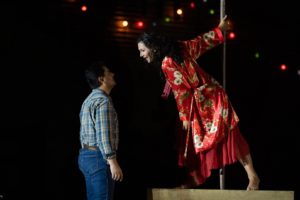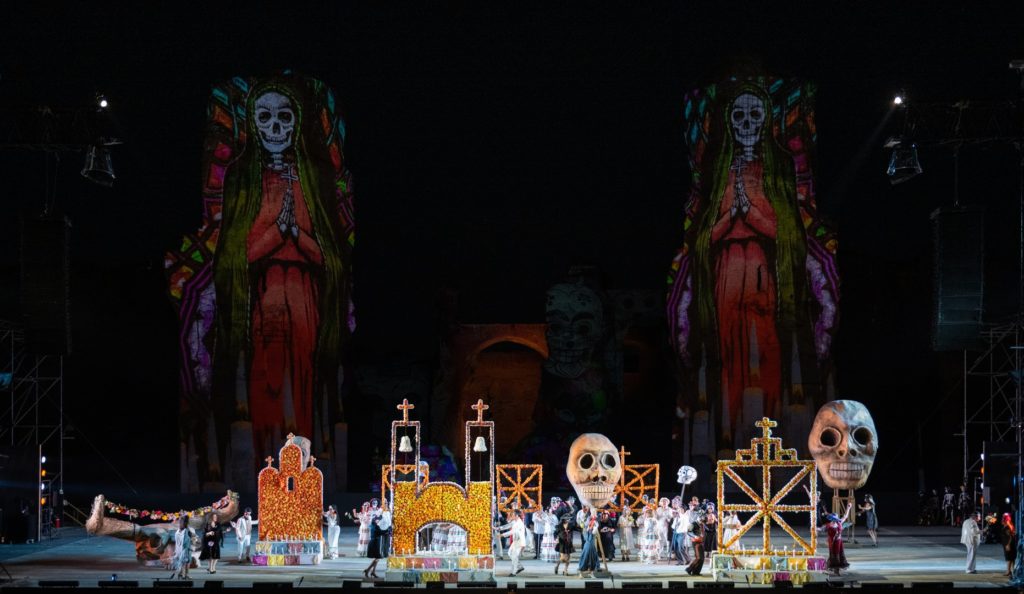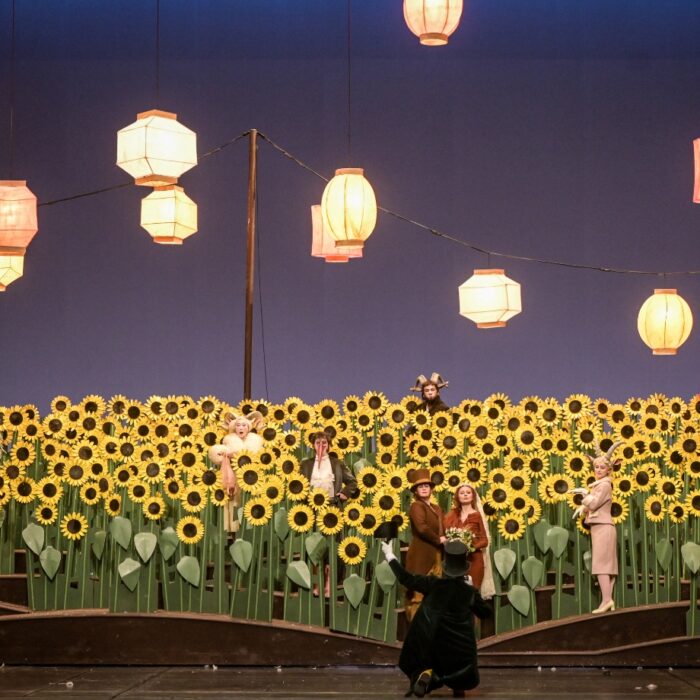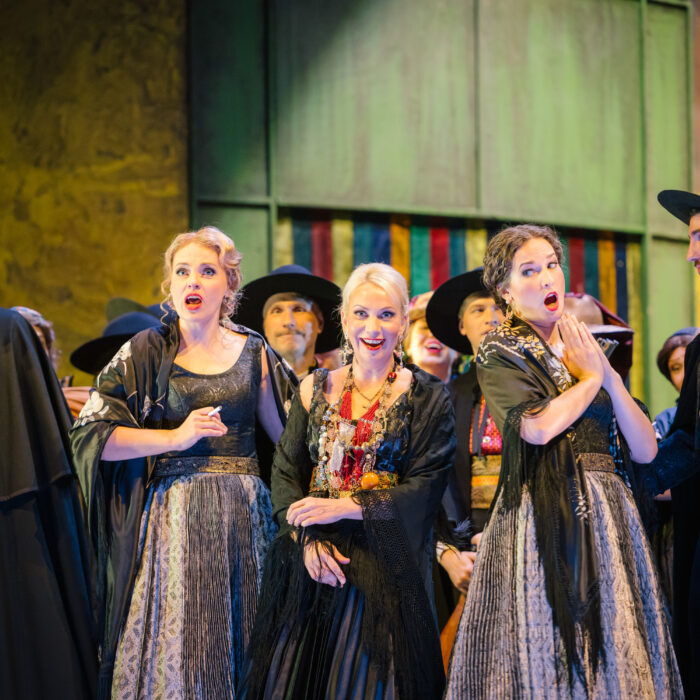
Teatro dell’Opera di Roma 2021-22 Review: Carmen
Saimir Pirgu Shines in Valentina Carrasco’s Trump Era Carmen
By Francisco Salazar(Credit: Ph. Fabrizio Sansoni / TOR)
After a two year absence from the Terme di Caracalla, the Teatro dell’Opera di Roma has returned. The company decided to open its summer season with a 2017 production of “Carmen” that sets the opera in a modern Mexico close to the border.
The result is a production that is timely due to the immigration crisis the U.S. is living through, but ultimately it is disappointing in many aspects.
Mexico & El Dias de Los Muertos
Valentina Carrasco directed the production when it first opened and brought some clever stagecraft. The final act is by far the most inspired. It begins with dancers dressed as skeletons in a witty choreography that then leads to a number of floats and projections of skeletal bodies and faces. There is also one float with a bull that Carmen and Escamillo arrive on. The action essentially takes place during El Dia de los Muertos, which is a traditional holiday in Mexico that celebrates family and friends gathering to pay respects and to remember friends and family members who have died. These celebrations can take a humorous tone, as celebrants remember funny events and anecdotes about the departed.
In this scene, we see many chorus members and dancers taking part in the festivities. It is quite a colorful scene and in some ways foreshadows Carmen’s imminent death. However, after the large chorus disappears, what we are left with is Don Jose and Carmen walking around the stage aimlessly with Carmen running in different directions but never with any clear escape route.
That is essentially the biggest issue with the production- not much happens throughout the evening. The second act, which takes place in a brothel, sees some of the chorus members implying sexual acts while Carmen and her friends pole dance. But it does not add up to much insight into the world we are in. The third act also sees the chorus stand in the back watching and never engaging with the action. In the first act, Carmen’s two biggest solos, the Habanera and Seguideille, are marred by aimless blocking that seems to eliminate any type of sensuality in place of walking around.
The other big issue with the production is that the ideas of illegal immigration are tied to Donald Trump’s America. They never seem to take form. In the beginning we see a truck filled with undocumented immigrants get unloaded by the police. Those immigrants are brought out, treated brutally, and soon disappear. There is never again a single mention of these immigrants until the pause between Act one and two where radio broadcasts in Spanish are heard as the hosts talk about Donald Trump and the border. That is then connected with Act three as it is assumed that Carmen and her friends smuggle immigrants through the border. However, it is never fully fleshed out in any of the actions or images that we see on stage. Neither Don Jose or Zuniga’s actions are fueled by racism. They are instead fueled by their obsession with Carmen.
This dialogue is also thrown out by some choices that seem more stereotyped and rooted in the criminal behavior that Trump essentially accused Mexicans of. We see kids with guns, reggeaton dancers, mariachis, men in sombreros, and a vegetable market. We see poverty, a bull skull but nothing more that takes away from Trump’s Mexico. One could interpret Jose’s policeman as a racist who takes advantage of a woman he becomes obsessed with and eventually murders her. It’s relevant if we think of the cruelty at the border or even the Black Lives Matter movement. But when we look at the actions on stage, one wishes Carrasco would have gone deeper in her imagery or even in her characterization of her lead characters. Still, I give her credit for bringing this important topic to the opera.

Carmen
For Carrasco, her interpretation of the free spirit is a woman who has many facets and nuances. In this production, she is an abused factory worker, a pole dancer, and then a smuggler. But even though she moves in numerous circles, her freedom is bound by her fate and the director shows us this through an apparition in the production. No matter how much she tries to escape, she is tied to her fate. This apparition in the form of a little girl comes on stage every moment that Carmen’s theme of fate comes in. We see the girl during her Act three card scene, Don Jose’s aria and in the Act one prologue, among other times. This is one of the most visually striking moments in Carrasco’s production and it is also perhaps the most enlightening.
Veronica Simeoni took on the title role of Carmen, reprising the production she originated in 2017. Simeoni displayed fierce physicality in the part, pole dancing, and even dancing with a toy snake as well as rolling around in the habanera and washing up in the seguidilla. In Act three she was defiant and threw herself to the ground. Act four also saw that defiance as she threw Jose’s ring with coolness and opened up her arms to accept her death.
However, her Carmen did have moments of vulnerability as she sang the card aria in Act three. One could visibly see Simeoni’s visage turn to hesitation and fear. In the Act four duet, she did seem fearful of Jose as she was thrown to the floor and struggled to escape Jose.
But not all of Simeoni’s interpretation worked. Sometimes the mezzo was too restrained, especially in the Habanera and Seguildilla which seemed very cool and reserved, while Act four saw the mezzo walking too much around the set taking away from the drama that was unfolding.
Vocally, the Italian mezzo does not have the plush or round sound that most expect from a Carmen. It’s a lighter lyric sound with some edge in the lower notes and in the higher range. However, Simeoni knows how to use the voice to great effect. She sang with a smooth legato line in the Habanera and Seguildilla and in “Les Tringles des sistres tintaient,” she emphasized the sensuality of her voice. Her “Tra la la la” were varied with silky tone and precise runs. She also built the piece from an unusually slow tempo to a quick and energetic one that emphasized Carmen’s free spirit.
In the quintet, Simeoni showcased her virtuosity in her patter-like phrases and her playfulness in the B section as she used a breathy sound as well as a sensual timbre to persuade her colleagues. Her Act two duet with Don Jose was a bit reserved but in Act three and four Simeoni really shined. In these last two acts, the mezzo seemed most free letting out a gritty and darker sound. Her “En vain, pour éviter les réponses amères” showed Simeoni bring out her chiaroscuro low notes that while not the most resonant, cut through with big impact. Her phrases gained some weight and volume as she climaxed to the end of the piece. Gone were the lush smooth lyric sounds from the first two acts and in place were the dramatic overtones that Simeoni was capable of.
In Act four, she sang with conviction as she decided on more spoken phrases that emphasized the text. Some of her higher notes, while a bit wobbly, were effective given the dramatic moment; when she was forced to bring out her full tone, Simeoni did so with a hard-edged tone. It was by far her biggest moment of the evening and she didn’t disappoint.
Don Jose
In the role of Don Jose, Albanian tenor Saimir Pirgu had a solid evening that got better with each act. Pirgu’s Don Jose is hotheaded from the very beginning which was displayed by his passionate singing in his duet with Mariangela Sicilia. If he lacked some more color in his dynamics, what Pirgu displayed here was how his Don Jose had little control over his feelings and instead was controlled by them.
But that hotheaded character seemed to temper in front of Carmen and in Act two as he sang “La Fleu que tu m’avais.” Here Pirgu sang with a tender tone and shaped each line with smooth legato phrases. Pirgu even added some hushed piano tones that eventually climaxed in his lines “j’etais une chose a toi.” He sang with a burnished sound that resonated throughout and which emphasized the intensity of this Don Jose. However, as he closed the aria with the line “Je t’aime,” he decrescendoed with the sound dying out beautifully.
Those piano lines didn’t seem to last long as Act three and four saw that hotheaded character return, this time with an unpredictability that turned violent. Pirgu handled his Act three moment with a powerful voice that displayed an aggressive tone. His actions turned from gentle to brutal as he took Simeoni’s Carmen by the neck, threatening her and throwing her around the stage. One could see Pirgu’s Don Jose unraveling and his voice continuing to gain more volume even at some points overmodulating the microphones.
In Act four, as he began the duet, the tenor began with a restrained tone on “Carmen, il est temps encore” as he attempted to convince his Carmen to return to him. But distraught by rejection, Pirgu’s Don Jose turned aggressive with the tone gaining strength and intensity. Pirgu also became more unpredictable and desperate as he ran after Simeoni, bringing her to the floor almost as if he were to rape her. His voice lost much of its gleam in favor of a more dramatic and heavy timbre which was effective. The high notes rang out with intensity especially in the “Pour la derniere fois, demon.” And towards the end after he killed Carmen, his final cries “Ah! Carmen” were heartbreaking.

Strong Support
In the role of Escamillo, Luca Micheletti showcased a suave baritone timbre that was refined with a gorgeous smooth timbre. His Toreador Song in Act two was among the highlights of the evening as he brought gravitas to the text and sang with passionate phrases. In his duet with Don Jose, Micheletti kept his cool at first but eventually let out a booming voice that equaled Pirgu’s unraveled Don Jose. At the end of the act, when he repeats the Toreador song, the singer sang with a seductive tone as his voice was heard off stage. His final vocal appearance came in Act four in his brief duet with Carmen. “Si tu m’aimes Carmen” was sung with extended long lines that demonstrated mastery of his breath control and a burnished tone that blended beautifully with Simeoni’s lyric sound.
Mariangela Sicilia portrayed Micaela as a tough woman who doesn’t let anyone control her. In the first scene, she confronted the police members by hitting them and in Act three, she went eye to eye with Carmen and even with Don Jose. It was refreshing to see this character portrayed in such a way because it gave Micaela more dimensions in her short but important scenes. Vocally, Sicilia was also strong throughout the evening. Her lyric tone was impressive in the duet “Parle-moi de ma mere!” where she displayed her long legato lines and bright sound. However, it was in her Act three aria “Je dis que rien ne m’épouvante” that she impressed most. She came onto the scene with a strong and imposing that showed the character’s determination and strength. Then in the B section “je vais voir de pres cette femme,” Sicilia sang with a piano and hesitant tone bringing out Micaela’s uncertainty. The phrases were shorter and filled with some breathiness. Still she relished in the longer lines, holding them out. When the aria returned to the A section, Sicilia built to the forte. She started out with a softer tone that emphasized Micaela’s sensitivity and also showcased a gorgeous and round lyrical voice. As she closed the aria, she decrescendoed on “Seigneur” with the sound dying away. The aria led the soprano to obtain a well-deserved ovation.
As noted in the following scene where she confronts Don Jose, Sicilia went for a passionate and strong voice in her first lines attempting to convince her Jose with the same sound from the opening duet. However, in “Helas! Jose, ta mere se meurt,” Sicilia brought out darker colors filled with pain and sadness as she never sang in full voice and instead maintained a softer hue in the dynamics.
The rest of the cast led by Daniela Cappiello, Anna Pennisi, Michele Patti, Marcello Nardis, and Alessandro Della Morte were solid.
Jordi Bernàcer led the orchestra and chorus with aplomb, moving the action forward. The orchestra always kept a strong balance between its singers and chorus, never covering a single soloist and instead allowing them to shine within their solos and ensembles. There was a moment where the orchestra and chorus seemed to get off but it was quickly corrected.
Overall this was a solid evening with solid soloists that make this revival worth a trip to the Terme di Caracalla.


